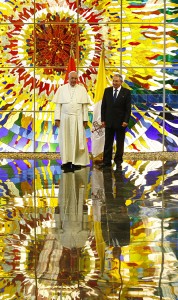Francis in Cuba
September 22, 2015

Pope Francis stands with Cuba’s president, Raúl Castro, in the Revolution Palace in Havana, Cuba, on September 20, 2015. Francis and Castro met in Cuba’s seat of government for a state meeting. Credit: © Tony Gentile, AP Photo
Pope Francis celebrated Mass on Monday, September 21, before more than 100,000 people in the eastern Cuban city of Holguín. Francis arrived in the Caribbean nation on Saturday, September 19, meeting with President Raúl Castro and his famous older brother, Fidel. Francis held Mass on Sunday in Havana’s Revolution Square, the scene of many blustery Castro speeches in the past. The Pope’s visit came at a time of political change between Cuba and the United States—change brought on largely by Francis himself. The Pope played an important intermediary role in the rapprochement (renewal of friendly relations) between the two countries earlier this year. For the first time since 1961, Cuba and the United States have open embassies in each other’s capital cities—Havana and Washington, D.C., respectively.
A native of Argentina, Francis and his words carry tremendous weight throughout largely Catholic Latin America. Huge crowds of people attended his spiritual sermons, but—to the disappointment of some anti-Castro dissidents—Francis was careful not to directly criticize the Cuban government. He did, however, get in a few veiled shots. Francis targeted the Communist—rather than “Christian”—ideals that have dominated Cuba since 1959. “Service is never ideological,” he said, “for we do not serve ideas. We serve people.” He also offered an embrace to all “those who, for various reasons, I will not be able to meet,” a reference to political prisoners, exiles, and others unable to freely attend the papal gatherings. Today, Pope Francis leaves Cuba for the United States.
Other World Book articles and Behind the headlines
- Cuba In From the Cold-July 21, 2015
- The Cold War’s Last Front: The United States and Cuba (2000-a Special report)
- Cuba (1958-a Back in time article)
- Cuba (1959-a Back in time article)
- Cuba (1962-a Back in time article)


